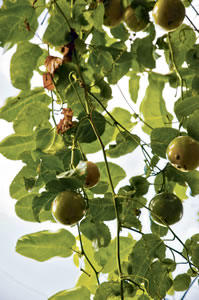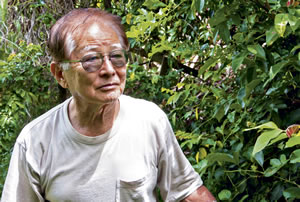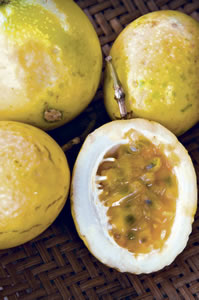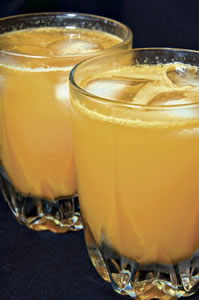A Passion For Luscious Lilikoi

Passion fruit flourishes in the wild throughout the Hawaiian Islands. Daniel Lane photos
George Mukai’s garden meanders throughout his residential property in Kapahi, where he cleverly uses natural organic material to protect his soil and eliminate pests.
What’s growing now: Asparagus, apple bananas, avocado, breadfruit, flowers, Hawaiian chili pepper, honey tangerine, lilikoi, lychee, macadamia nut, mango, mulberry, noni, Okinawan spinach, oriental squash, papaya, pomelo, short yard beans, soursop, star fruit, sweet pepper.
LILIKOI (PASSION FRUIT)
There are more than 15 varieties grown in Hawaii, originating from strains of yellow and Australian purple passion fruit. Purple lilikoi have a higher juice concentration than yellow, are less acidic, and are prized for their rich aroma and flavor. They grow in subtropical climates and thrive at altitudes between 2,000 and 4,000 feet. Yellow passion fruit grow in tropical or near tropical climates at lower elevations.

George Mukai, food forest farmer
Season: Passion fruit matures from June through January, with heaviest crops in July, August, October and November.
What to look for: Select fruit that is lemon yellow or dark lavender, with smooth, shiny skin and little to no dark spots.
Storage: Lilikoi rapidly ripens at temperatures of 86 degrees, but will keep for a week in the refrigerator.
Tip: If the fruit is allowed to wrinkle, the juice will be sweeter, although you can enjoy it before it shrivels.
Preparation: The juice, pulp and seeds are edible. Spooning the seeds and pulp straight from the fruit and into your mouth is a popular way to eat them. Australians mix it with cream and sugar. It can be used as a yogurt topping, in salads and beverages. Strained pulp and juice can be boiled down to a thick syrup and used in desserts, ice cream and cake fillings.

Lilikoi has a tangy, slightly sweet flavor
Health benefits: Passion fruit is high in beta-carotene, an excellent source of niacin (B3) and a good source of riboflavin (B2). Niacin is a coenzyme that is vital for proper activity of the nervous system, healthy skin, tongue and digestive system tissues. Niacin is necessary for the synthesis of sex hormones, supports detoxification, lowers cholesterol, and helps with Type 1 diabetes and arthritis.
George Mukai’s produce can be found at:
The Anahola Fruit Stand and Kapa’a Fruit Stand by JJs Pizza. Mukai’s passion fruit is in Nani Moon Mead’s Winter Sun and Monkeypod Jam’s Lilikoi Curd. Mukai sells most of his produce to Esaki’s. “George’s produce goes to all the hotels, grocery stores and restaurants islandwide,” says Esaki’s sales manager Craig Ishida. Call 8224568.
It’s been so hot lately, I have been craving something cold and refreshing. Fresh and fruity drinks do the trick, plus, I feel a little healthier drinking them. My husband Daniel, our house mixologist, created this recipe. Omit the vodka for an alcohol-free alternative.

Passionate Orange Juice
PASSIONATE ORANGE JUICE
* 4 or 5 lilikoi
* 1 cup fresh squeezed orange juice, about 3 oranges
* 3/4 cup chilled vodka
* 5 ice cubes
* sparkling water, chilled
Cut lilikoi in half; scoop the insides into a blender or food processor and blend for 30 seconds. Place strainer over a glass measuring cup and press juice out. Alternatively, I like to set it in the refrigerator in the morning, so by evening it’s strained and chilled.
Combine 1/3 cup lilikoi juice, orange juice, vodka and ice cubes in a martini shaker, and give it a good shake until the sides of the shaker are cold. Pour glasses half full, top with sparkling water, stir and serve immediately.
Makes four servings.



